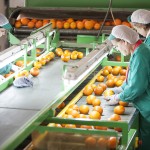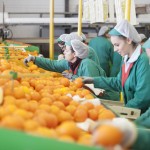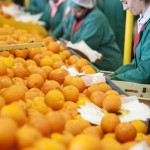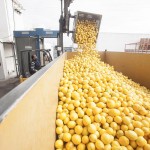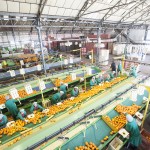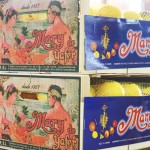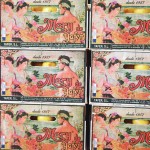OUR VARIETY
Description of the varieties.
Orange - Navelina
 Detected in California in 1910. Provided by University of California at IVIA, Spain, in 1933, where it is given the name Navelina. Not up to the nurseries until 1968. Should be vigorous but medium sized tree. However it is very productive.
Detected in California in 1910. Provided by University of California at IVIA, Spain, in 1933, where it is given the name Navelina. Not up to the nurseries until 1968. Should be vigorous but medium sized tree. However it is very productive.
Taste: Pulp sweet, very juicy and of excellent quality.
Morphology: The fruit is large, roundish or slightly oval. The crust is normal, smooth and bright orange thick.
Juice content: 38.0-50.0%
Maturity: 7.0-15.1%
Orange - NAVELS
 The tree from which grow well in Mediterranean-type climates. The feature different varieties of this group, is the navel (called "navel"), which have in part the fruit opposite the stem.
The tree from which grow well in Mediterranean-type climates. The feature different varieties of this group, is the navel (called "navel"), which have in part the fruit opposite the stem.
Taste: Rich, sweet and pleasant taste. Its flesh has a sweet taste that makes it a hard to beat fruit table.
Morphology: Your skin has a bright orange and peels easily. Its fruit is large and seedless.
Juice content: 40.0-48.0 % %
Maturity: 7.5-15.5
Orange - NAVELS POWELL

The tree from which grow well in Mediterranean-type climates. The feature different varieties of this group, is the navel (called "navel"), which have in part the fruit opposite the stem.
Taste: Rich, sweet and pleasant taste. Its flesh has a sweet taste that makes it a hard to beat fruit table.
Morphology: Your skin has a bright orange and peels easily. Its fruit is large and seedless.
Juice content: 55.0-58.0 %
Maturity: The mature fruit maintains good adhesion to the stem, allowing a later harvest.
Orange - NAVELS CHISLETT

Washington mutation originated in Australia. Tree vigorous, with some thorn branches greater vigor. The flowers have no pollen and like other varieties of navel group, the fruits have navel.
Taste: Rich, sweet and pleasant taste. Its flesh has a sweet taste that makes it a hard to beat fruit table.
Morphology: Your skin has a bright orange and peels easily. Its fruit is large and seedless.
Juice content: 55.0-58.0 %
Maturity: The mature fruit maintains good adhesion to the stem, allowing a later harvest.
Orange - Salustiano
 Originating in Valencia by spontaneous mutation Commune. The tree from which this variety is vigorous, well developed and productive.
Originating in Valencia by spontaneous mutation Commune. The tree from which this variety is vigorous, well developed and productive.
Taste: Fine, rich, sweet flavor. Its flesh is very juicy, and has a high juice content quality. Hardly any seeds.
Morphology: It is medium to large, round-oblate shape, with a slightly rough and medium thick crust.
Juice content: 40.0-52.0 % %
Maturity: 8.5-15.0
Orange - LANE emotions
 Was detected in 1950 in Australia as a spontaneous mutation of Washington Navel. The tree from which is vigorous, large, very productive and precocious.
Was detected in 1950 in Australia as a spontaneous mutation of Washington Navel. The tree from which is vigorous, large, very productive and precocious.
Taste: Sweet and pleasant flavor, and low in limonene, which makes your juice is less bitter than other varieties. The pulp has good organoleptic qualities.
Morphology: The fruit is large, bright orange rind and low roughness. The navel is hardly visible to the outside.
Juice content: 36.0-50.0 % %
Maturity: 8.0-14.9
Orange - NAVELS LATE
 It originated as a spontaneous mutation of Washington Navel Vinaroz detected in 1948.
It originated as a spontaneous mutation of Washington Navel Vinaroz detected in 1948.
The tree is vigorous, has good development and has some thorns.
Taste: Sweet and pleasant flavor, and low in limonene, which makes your juice is less bitter than other varieties. The pulp has good organoleptic qualities.
Morphology: The fruit is medium to large, slightly lower than Washington Navel, pale orange and extraordinary quality. Seeded.
Juice content: 36.0-50.0 % %
Maturity: 8.0-14.9
Orange - VALENCIA LATE
 Its origin is in the Azores, in the S XIX, as a spontaneous mutation. The tree from which this variety is large, vigorous and very productive.
Its origin is in the Azores, in the S XIX, as a spontaneous mutation. The tree from which this variety is large, vigorous and very productive.
Taste: The pulp has good color, and a high juice content slightly acidic taste.
Morphology: The fruit has a medium to large size, it is round and slightly elongated. The bark is thin, smooth and bright orange. Easy to peel and seed barely.
Juice content: 40-53 % %
Maturity: 7.0-11.0
Lemons - PRIMOFIORI
This variety is of unknown origin. The tree is vigorous, thorny and very productive.
Taste: High in juice of high acidity.
Morphology: The fruit is spherical or oval; The bark is smooth and thin, and the nipple is short compared to the Verna variety. Has an average number of seeds.
Lemons - VERNA
 Variety of unknown origin, although it has never been grown outside Spain. Verna tree is large and with few thorns.
Variety of unknown origin, although it has never been grown outside Spain. Verna tree is large and with few thorns.
Taste: The flesh is tender, with juice content with good acidity, although less so than in other varieties.
Morphology: Fruit medium to large, neck roughly pronounced in the stem region. The crust is somewhat rough and coarse.
Clementines
It is the most popular variety of Clementina in Spain. Detected as a mutation of Fina in 1953 Nules (Castellón). Early harvesting is staggered and in turn function of flowering. It comes from a vigorous tree, well developed and very productive.
Taste: It has good content in high quality juice with adequate levels of sugar and total acids. Its flesh is juicy and very good quality.
Morphology: Fruit of good size and somewhat flattened. The bark is bright orange and easy to peel. Seeded.
Juice content: 40.0-52.0 % %
Maturity: 8.0-15.7 ° BRIX from the beginning
 OROGRANDE Selecting Clemenules obtained in Murcia, in which minor differences on the original variety is appreciated (abscission of young shoots in bloom is lower and the percentage of fruit to harvest in a first pass is greater). The tree is vigorous, and some have little spinosity multiyema gall. Flowering may occur staggered in time. Pollen has high germination. It is self-incompatible and parthenocarpic.
OROGRANDE Selecting Clemenules obtained in Murcia, in which minor differences on the original variety is appreciated (abscission of young shoots in bloom is lower and the percentage of fruit to harvest in a first pass is greater). The tree is vigorous, and some have little spinosity multiyema gall. Flowering may occur staggered in time. Pollen has high germination. It is self-incompatible and parthenocarpic.
 ORONULES: Clementina Fina mutation originated in Nules (Castellón). Tree vigorous, albeit slow growth, boneless and with narrow leaves. Pollen has high germination. Variety is parthenocarpic and self-incompatible.
ORONULES: Clementina Fina mutation originated in Nules (Castellón). Tree vigorous, albeit slow growth, boneless and with narrow leaves. Pollen has high germination. Variety is parthenocarpic and self-incompatible.
 CLEMENULES: Mutation of Clementina Fina, originated in Nules (Castellón).
CLEMENULES: Mutation of Clementina Fina, originated in Nules (Castellón).
PRODUCTION SCHEDULE



SOME PICTURES




